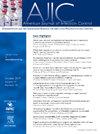The impact of a novel color additive for disinfectant wipes on room cleanliness and turnover time
IF 3.8
3区 医学
Q2 INFECTIOUS DISEASES
引用次数: 0
Abstract
Background
Contaminated environmental surfaces in the health care setting put patients at risk of acquiring health care-associated infections. Highlight (Kinnos) is a novel color-additive technology for disinfectant wipes that helps users visualize surfaces that have been cleaned by producing a transient color on wiped surfaces that fades off after effective cleaning.
Methods
To quantify the impact of real-time visual feedback on room cleanliness and efficiency, a pre-post quasi-experimental study was conducted by comparing Replicate Organism Detection and Counting (RODAC) plate counts and room turnaround times with and without the use of the color additive.
Results
Compared with the control group of disinfectant alone, disinfection with the color additive resulted in a 69.2% improvement in room cleanliness accompanied by a 5.9% faster room turnover time.
Discussion
As far as we know, this study is the first to publish on the impact of a novel color additive on the environment of care as measured by microbial culturing and room turnaround times, finding advantages in both metrics relative to the status quo.
Conclusions
The use of real-time visual feedback can improve the thoroughness of disinfection cleaning while maintaining operational efficiency.
用于消毒湿巾的新型颜色添加剂对房间清洁度和周转时间的影响。
背景:医疗机构中受污染的环境表面会给病人带来感染医疗相关疾病的风险。Highlight (Kinnos)是一种用于消毒湿巾的新型增色技术,它能在擦拭过的表面产生瞬时颜色,并在有效清洁后褪去,从而帮助用户直观地看到已清洁过的表面:为了量化实时视觉反馈对房间清洁度和效率的影响,我们进行了一项事前-事后准实验研究,比较了使用和不使用颜色添加剂时的重复生物检测和计数(RODAC)平板计数和房间周转时间:结果:与只使用消毒剂的对照组相比,使用颜色添加剂进行消毒后,房间清洁度提高了 69.2%,房间周转时间缩短了 5.9%:讨论:据我们所知,这项研究是第一项通过微生物培养和病房周转时间来衡量新型彩色添加剂对护理环境影响的研究,发现这两项指标相对于现状都有优势:结论:使用实时视觉反馈可以提高消毒清洁的彻底性,同时保持运行效率。
本文章由计算机程序翻译,如有差异,请以英文原文为准。
求助全文
约1分钟内获得全文
求助全文
来源期刊
CiteScore
7.40
自引率
4.10%
发文量
479
审稿时长
24 days
期刊介绍:
AJIC covers key topics and issues in infection control and epidemiology. Infection control professionals, including physicians, nurses, and epidemiologists, rely on AJIC for peer-reviewed articles covering clinical topics as well as original research. As the official publication of the Association for Professionals in Infection Control and Epidemiology (APIC)

 求助内容:
求助内容: 应助结果提醒方式:
应助结果提醒方式:


